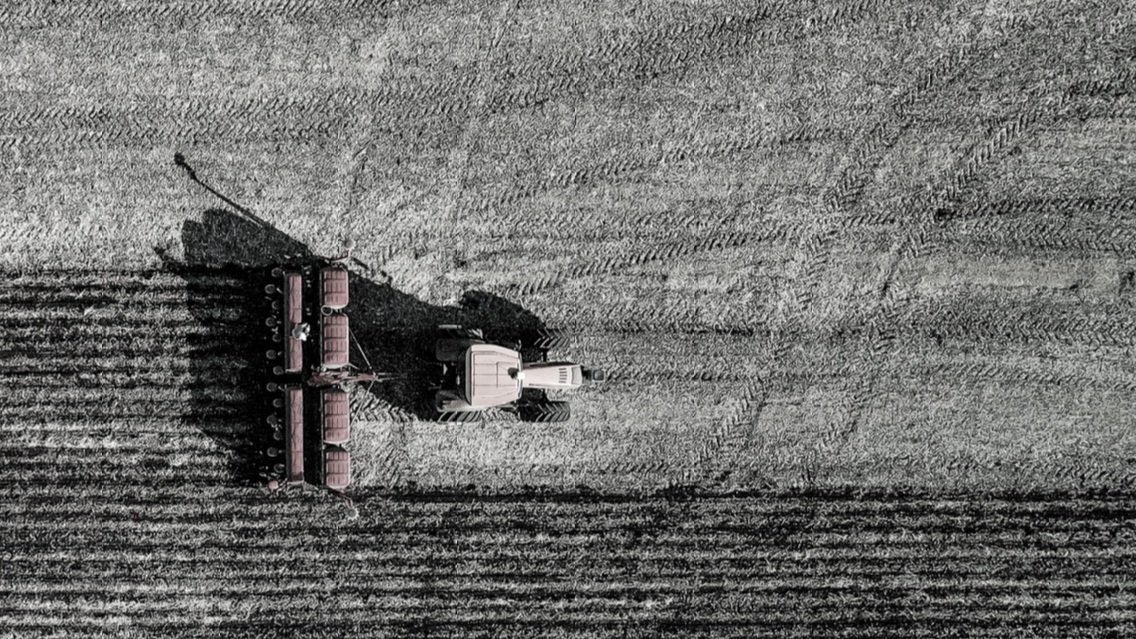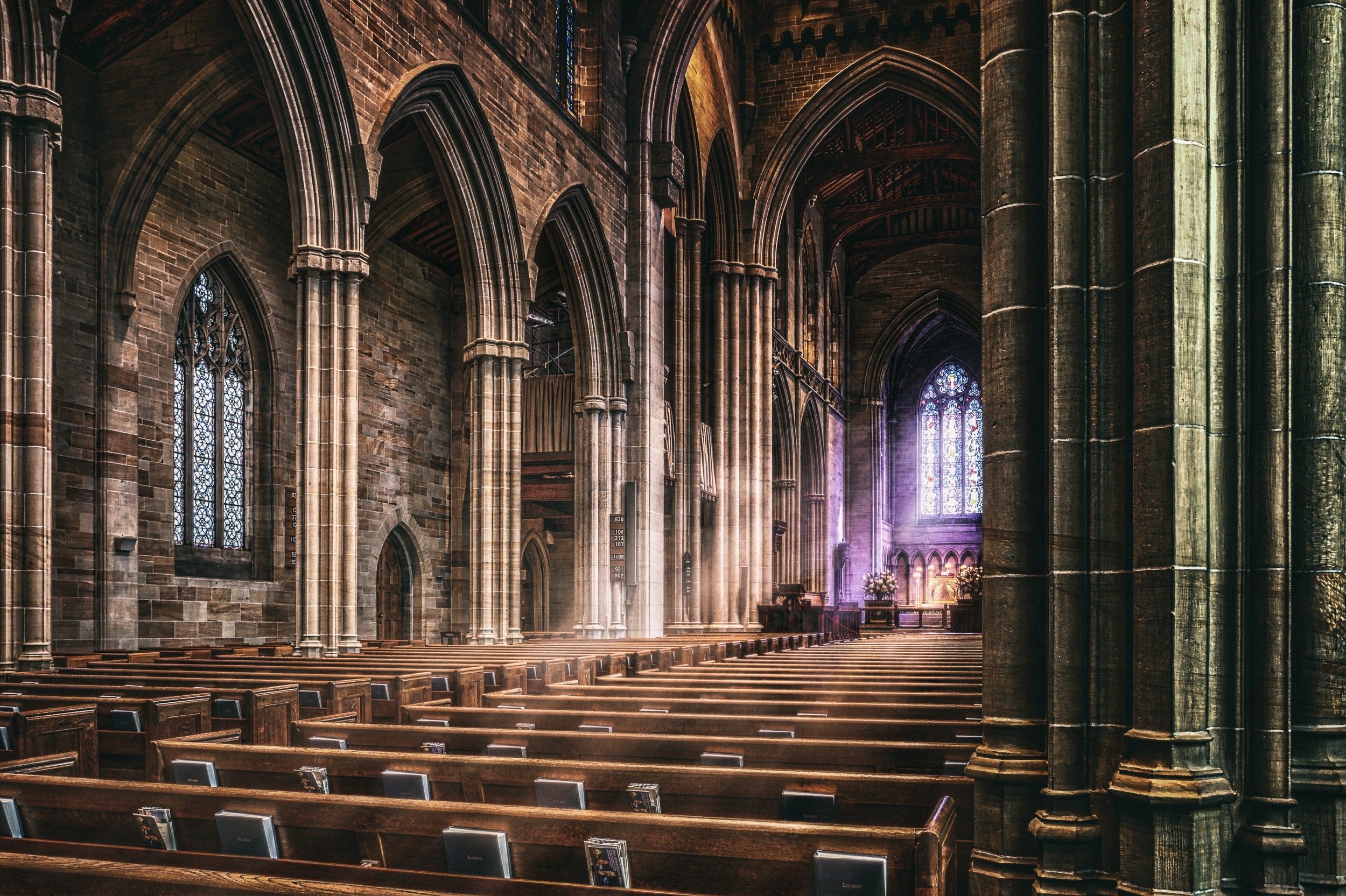Our Meander
December 27, 2022 | Lukas Bacho SM’25
During my first semester at Yale, I made a habit of walking up to the Divinity School just before each of our three breaks: October, Thanksgiving, and Winter. There’s a labyrinth there, carved into the stone of a courtyard just behind Marquand Chapel. Almost without thinking, I’d walk its length from the entrance to the center, then back out again, glancing sheepishly at the windows of surrounding buildings for any sign of my being watched. It felt clandestine, or maybe pretentious, this act of contriving a spiritual journey in a matter of steps. My Calvinist heart distrusted the show of it. But something inside me opened upon my emergence from the labyrinth, for I’d descend Prospect Hill praying aloud to God as if he were walking beside me, something I had seldom done before.
As it turns out, labyrinths have figured in Christian iconography and practice since the Early Church, when priests drew heavily on Greek rituals and stories to form their liturgy. The Christian labyrinth has its origins in the Greek myth of Daedalus, who built a maze to entrap the Minotaur, the bastard progeny of a bull and the Cretan king’s wife. The Athenian prince Theseus, following Daedalus’s instructions, was able to kill the Minotaur and escape the Labyrinth only by tying a golden thread to its entrance and following the thread back out. [1] While this labýrinthos—of which representations have been found in Cretan palaces, caverns, and coins—is the etymological origin of our English word, we generally define a labyrinth as having a single pathway—that is, a meander—from entrance to goal, rather than an impossible tangle of forking paths. [2]
This can be attributed, in part, to the Christian adoption of the labyrinth, whose earliest known example was at the Basilica of St. Reparatus in present-day Algeria, dating to 324 A.D. Its center exchanged the usual depiction of Theseus and the Minotaur for the words Sancta Ecclesia, or “Holy Church.” [3]
As with most Early Christian iconography, it is hard to know whether our first labyrinths represent an incidental fusion of cultures or an intentional ecclesiastical move. Whatever the case, the analogy between Theseus and Jesus came to fruition in the Middle Ages, when the eleven-circuit floor labyrinth at Chartres Cathedral became the archetypal design (of which our Divinity School labyrinth is an eight-circuit variation). The literature tells us that on Easter, a European priest might walk a labyrinth and toss a yellow ball of wool to parishioners along the labyrinth’s circumference as they danced and chanted “praises to the Easter Victim.” [4] Theseus had become Christ, the Minotaur Satan, the labyrinth our sinful world, and the golden thread our faith. At the center of it all lay the heavenly Jerusalem.
In the 17th and 18th centuries, French Catholic authorities destroyed many church labyrinths on the grounds that they had become distractions rather than vehicles for mystical experience. It wasn’t until the 1990s that labyrinth construction found its revival in a movement that began at Grace Cathedral in San Francisco, where I attended middle school. [5] Today, some Christians deride labyrinths as pagan or New Age symbols, as indeed they once were and continue to be in some places. Yet it bears noting that our religious forebears walked labyrinths before they constructed them: in the second century, when Christianity was a still a cult of outcasts, the faithful met in shadowy catacombs, or labyrinthos, beneath Hellenistic Rome. [6] I was oblivious to this as a young boy, when my fellow choristers and I played tag in the basement labyrinth of a Presbyterian church before we sang upstairs. Although the meander features a single path, its history branches into myriad meanings.
One such meaning finds its expression in Czech author John Amos Komensky’s 1623 book Labyrinth of the World and Paradise of the Heart. This Baroque satire, divided into short chapters with helpful headers, wears its allegorical meaning on its sleeve. The central author-pilgrim, having reached the age at which he must choose a career, surveys a host of worldly occupations with the help of two guides: Searchall Ubiquitous (or Impudence) and Delusion (or Falsehood). The former, upon meeting Komensky, asks him if he has heard of the famous Cretan labyrinth. Searchall describes its impossible multiplicity of passageways, only to declare that “this was nothing compared to the way in which the labyrinth of this world is fashioned, particularly in these times. I do not, believe me, counsel a prudent man to enter it alone.” [7]
Komensky soon discovers that the world is an overwhelming maze of appearances, temptations, and suffering. It is only when he cries out for God’s mercy that God counsels him to “return” from the worldly labyrinth and into his quiet heart, where Christ will meet him. [8] Here Komensky is in dialogue with the robust Christian dialectic going back at least to Augustine, who drew on Plato: that which occurs between body and soul, sense-perception and reason, temporal and eternal, the City of Man and the City of God. [9] While Medieval sources located God at the center of the labyrinth, Komensky seems to locate God outside the labyrinth, placing greater emphasis upon the exit journey—though the paradisal heart of his title certainly lies at the center of the body and, by extension, the world. As in Christian symbolism more generally, the maze of forking paths becomes a meander with a single, determined path, but the latter retains an echo of the former beyond its etymology.
Walking a labyrinth like the one at the Divinity School, one might grow incredulous at the tedium of its hairpin turns, which guide the pilgrim toward the center only to double back toward the labyrinth’s outermost rings. As a child, I was often tempted to hop lines and cut corners. Of course, the circuitousness is the point, indicating a lesson of which Christians must continually remind themselves. While the goal retains its symbolic importance, nearly all the emphasis is on the pilgrimage of life, the sole site of our agency.
So far, I have mentioned two labyrinths I grew up around, one of them being in Grace Cathedral and the other in a Presbyterian church. At least another comes to mind. It was at Lands End, that wind-battered segment of San Franciscan coastline I’ve come to know so well. Hiking its length with my family or friends, I’d clamber down a path onto a flat-topped outcropping whose edges dropped into the Pacific on three sides. Someone—Eduardo Aguilera, I now know from an online search—had built a labyrinth out of rocks there. Its outermost ring ran perilously close to the cliffs, and I remember being struck by its fragility each time I walked it. Exposed as it was to the elements and the feet of running children, the labyrinth could have easily been destroyed.
Still, from my earliest memory through all my years of childhood, the Lands End labyrinth persisted. Its designer seemed to me—to us—ineffably generous, so much so that we reciprocated with our own generosity. I still hear a certain reverence in visiting parents’ cautions to their children. The structure exemplified what the writer Marilynne Robinson has called “a givenness that in its fullness reflects divine intent,” [10] as well as entelechy, a word meaning “the active principle of wholeness or completion in an individual thing.” [11] This principle, Robinson asserts, is essential to our experience of grace and beauty, and by extension to our experience of God.
I didn’t grasp this until I returned to Lands End during the COVID-19 pandemic and was startled to find no trace of the labyrinth. It was gone, swept away like a Tibetan Buddhist mandala. [12] As I regarded the empty clearing, which was forever imprinted with the labyrinth in my mind’s eye, my attention turned to the cliffs and the sea. Although I could not articulate this then, I recognized the vast design which had surrounded the labyrinth and indeed given rise to it. Before me lay what exists with a beginning and an end all at once, that to which all artificial labyrinths should ultimately turn our attention—that which Komensky called, not without a sense of humor, the great labyrinth of the world.
. . .
As I walked the Divinity School labyrinth for the second or third time, I had a second small epiphany. The labyrinth had charmed me, in part, by resolving the apparent contradiction between divine foreknowledge and human free will. I have mentioned how the symbol recalls the eternity of God’s design, as though it were a map of time itself—a resemblance intensified by the proliferation of the Chartres design throughout the intervening centuries. Interestingly, labyrinths seem to have arisen independently and for different purposes in many ancient civilizations, from India and Cyprus to Scandinavia and the Indigenous Americas.
To borrow Robinson’s word, we experience labyrinths as given; as Augustine observes of created things, “the very fact that they are there proclaims that they were created.” [13] The labyrinth begs our metaphysical interpretation. If we are to trust the Medieval churches, a meander both sets out God’s single, correct path from birth or denial to salvation and requires our free participation in it. Enfolded in its rings, I have had the strange experience of total agency and almost hypnotic surrender: at any point, I could have turned back, cut corners, or disregarded its lines altogether; but now, more than in my childhood, I could not bring myself to escape its inertia. Labyrinths mimic the process by which we must choose God in our every step, even as God draws us to him, watching from above, his whole design in view.
Happily for me, there is something deeply Puritan about this. I have yet to successfully impart to anyone how John Calvin’s explications of prescience and predestination bring me comfort, but perhaps the labyrinth is an accessible image at which to start. For Calvin, God’s prescience means “that all things always were, and ever continue, under his eye; that to his knowledge there is no past or future, but all things are present, and indeed so present…that he truly sees and contemplates them as actually under his immediate inspection.” [14] Calvin’s definition recalls the entelechy of the labyrinth, God’s bird’s-eye view of it. Augustine refers to “prescience” in his Confessions and City of God, and it lurks in the margins of his argument for the compatibility of human agency and divine foreknowledge in On Free Choice of the Will. Our movement toward God, like our movement through a labyrinth, is essentially individual because it requires the constant exercise of free will, even as God’s knowledge of our actions is unbounded by time. Our free will, like the givenness of Creation itself, is a manifestation of God’s grace.
And besides, labyrinths are fun. How appropriate it is that children, even more eagerly than we, rejoice in them! Maybe I felt awkward walking the Divinity School labyrinth because I felt like a child again; but, as Jesus tells his disciples, “Whoever becomes humble like this child is the greatest in the kingdom of heaven.” [15] Perhaps the Christian labyrinth can help us reclaim a sense of play that we have lost. The 20th-century German theologian Karl Barth entreats us to “play properly,” even in our work, for “when children play properly, of course, they do so with supreme seriousness and devotion.” [16]
C. S. Lewis further suggests that playful pretense is necessary for and intrinsic to faith—even saying “Our Father” in the Lord’s Prayer is itself an act of pretense, of “dressing up” as God’s only begotten Son. [17] And Augustine’s Confessions is not without play, either, employing a syntax that dilates and contracts, doubting and affirming, constantly doubling back on itself. Augustine seems to suggest that confession, at its best, reflects the restless yet focused rhythm of a meander. So the pretension of walking a labyrinth might be helpful, not distracting, as long as we acknowledge it as such. Those switchbacks quiet the mind and shape its thought.
The Church today—particularly my beloved, Reformed corner of it—is grievously disembodied. Like the rest of contemporary life, it has become sterile, even clinical. While we are fortunate that scientific progress and social change have enabled us to push death out of the public sphere and into hospital rooms and morgues, we are worse equipped than ever for conceptualizing the graphic, bodily tragedy at the center of Christianity. [18] It is appallingly easy to forget the Good News that God became man and suffered with us. The labyrinth, however, can help us playfully reclaim the sensual dimension of our relationship with Christ, then position the senses in service of the soul. The labyrinth can incline our ears anew to that most Christian of invitations: Walk with me. [19]
“Daedalus.” Encyclopaedia Britannica, 30 May 2021, www.britannica.com/topic/Daedalus-Greek-mythology. Accessed 18 Jan. 2022.
Saward, Jeff. “Mazes or Labyrinths...What’s the Difference and What Types Are There?” Labyrinthos, 2017, labyrinthos.net/archives.html. Accessed 18 Jan. 2022.
“Prayer Labyrinth.” Grace Chapel, www.grace.org/labyrinth/. Accessed 18 Jan. 2022.
“Prayer Labyrinth.”
“Our Labyrinths.” Grace Cathedral, gracecathedral.org/our-labyrinths/. Accessed 18 Jan. 2022.
White, L. Michael, and John Dominic Crossan. “In the Catacombs.” Frontline, PBS, www.pbs.org/wgbh/pages/frontline/shows/religion/first/catacombs.html. Accessed 23 Apr. 2022.
7 Komensky (Comenius), John Amos. Labyrinth of the World and Paradise of the Heart, II.2. Translated by František Lützow, e-book ed., E. P. Dutton and Company, 1901. Wiki. https://en.wikisource.org/wiki/The_Labyrinth_of_the_World_and_the_Paradise_of_the_Heart_(1901).
Komensky, XXXVII.1.
See Augustine of Hippo. Confessions, I.5, IV.10, VII.9–10, VIII.10, X.6; On Free Choice of the Will, I.6, I.15, II.19; City of God, VIII.9, XI.1, XIV.1. Augustine wrote these works in 397–400, 388, and 413–427, respectively.
Robinson, Marilynne. What Are We Doing Here?, p. 37. Farrar, Straus and Giroux, 2018.
Robinson, 106.
In my research, I discovered that the labyrinth was first built in 2004 and vandalized several times, most notoriously in 2011 and 2015. Since the onset of the pandemic, however, vandalism has become more frequent; between the summers of 2020 and 2021, the labyrinth was completely destroyed three times.
Gentile, Dan. “San Francisco’s Lands End Labyrinth Keeps Getting Destroyed. Will
It Be Back?” SF Gate, 14 Aug. 2021, www.sfgate.com/sf-culture/article/
San-Francisco-labyrinth-lands-end-golden-gate-park-16385346.php. Accessed
18 Jan. 2022.
Augustine, Confessions, XI.4.
Calvin, John. Institutes of the Christian Religion, III.21.5. Translated by Henry Beveridge, vol. 3, Canon Press, 2020. 4 vols. Christian Heritage Series. Beveridge’s translation is based on the final Latin edition of 1559.
Matt. 18:4 (NRSV).
Barth, Karl. A Karl Barth Reader, p. 93. 1985. Edited by Rolf Joachim Erler and Reiner Marquard, translated by Geoffrey W. Bromley, William B. Eerdmans Publishing Company, 1986.
Lewis, C. S. Mere Christianity, p. 161. 1943. 3rd ed., Macmillan, 1952.
Fleming Rutledge examines this phenomenon, among many others, in her masterful 2017 book, The Crucifixion: Understanding the Death of Jesus Christ (Eerdmans).
See Matt. 4:19, 16:24.




February 1, 2023 | Zeki Tan PM ‘25
This culture of isolation was on full display during the Covid-19 pandemic, in which many people died alone in the hospital, their families denied visitation under lockdown rules. How did these people feel as death approached? Perhaps they still had dreams to fulfill, places they wanted to visit, or people they wanted to see when Death came knocking.